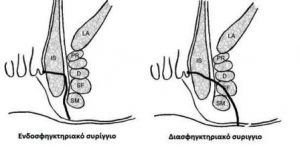Perianal Fistula and Treatment
Perianal fistulas are treated only surgically and persist until they are removed. Fistulas are treated with different methods, depending on whether they are small, medium or high. For low or small fistulas, the conventional surgery, such as fistulotomy for perianal fistula seems to be relatively safe and well accepted in clinical practice even today.
For medium and high, however, techniques have evolved considerably to protect the function of this very delicate area – that is, to prevent the patient from presenting bowel incontinence or other unpleasant complications.
Their therapy with classical (conventional) surgical techniques, such as removal of the fistula, or Setton (Hippocrates’ technique), is inevitably accompanied by destruction of the sphincter and subsequent malfunction of the area, causing permanent failure and incontinence, also presenting high recurrence rates.
For this reason, techniques have been developed to preserve the sphincter, preventing recurrences. The most representative ones of these are the interpharyngeal fistula ligation, the insertion of a special plug into the fistula (derived from the submucosal porcine small bowel), the use of a special fibrous glue and the FiLaC technique, using a special laser fibre optic.
The Ligation of Intersphincteric Fistula Tract or LIFT procedure appears to safe and effective with relatively little injury to the area. The insertion of a special plug and the use of fibrous adhesive have limited use and low healing rates. The technique laser technique is slowly gaining considerable ground and appears to be approaching the ideal treatment for anal fistulas, which should aimed at eliminating the sepsis and permanently healing the fistula with as little tissue injury as possible, while preserving intact the sphincters and the mechanism of continence.
Treatment of Anal Fistula with Laser
The main objective of FiLaC laser treatment (Fistula – track – LaserClosure) is the closure of the perianal fistula without without injury to the sphincter, the intact preservation of every part of the sphincter and the muscle tissue and minimizing the possibility of incontinence.
The treatment, which consists of closing/closing the fistula with the using the EVOLVE laser and a special optical fiber with circular diffusion of energy, is carried out by the advancement and precise positioning of the optical fiber in the fistula, guided by the special beam of the laser. As the optical fiber is retracted, we apply laser energy which destroys the epithelial tissue in a controlled manner and converges/seals the walls of the fistula.
FiLaC treatment has the following significant advantages:
- It ensures good control of the intervention, without trauma, preserving intact the sphincter mechanism and the sphincter’s function.
- It is applicable for all fistula lengths
- The flexibility of the fiber ensures access even to fistulas with difficult anatomy
- The operation lasts only a few minutes
- The laser energy accelerates the healing process
- The treatment can also be combined with other techniques for closing the orifice
- It is the safest treatment with the highest healing rates
- It is applied with absolute safety in patients with Crohn’s disease and multiple fistulas
Our experience in this technique is more than encouraging
The results of the first statistical study we have carried out leads us to believe that we are close to the ideal treatment. We started applying laser therapy in 2012, first in Greece and one of the first in Europe in almost all of our patients. In the last two years (2015-2016), after own modification-evolution of the technique, the percentage of healing rate reaches 95%.
The easy application and the impressive results give us the possibility to use the specific optical fiber (laser) on other fistulas – medium or low – because the healing time and the post-operative discomfort of the patient is much shorter compared to all the other techniques.
Treatment of anal fistula with Laser
The main goal of FiLaC (Fistula – track – LaserClosure) laser treatment is to close the perianal fistula without causing injury to the sphincter, to preserve any part of the muscle tissue intact and to minimize the possibility of bowel incontinence.
The treatment consists in the closure of the fistula using the EVOLVE laser and a special optical fiber with circular energy diffusion.
The treatment is carried out by advancing and precisely positioning the optical fiber in the fistula, guided by the special laser beam. As the optical fiber is withdrawn we apply laser energy that destroys the epithelial tissue in a controlled manner and converges – seals the fistula walls.
FiLaC treatment has significant advantages:
- Ensures good control of the intervention, without trauma, keeping intact the sphincteric mechanism and the function of the area
- Applicable for all fistula lengths
- The flexibility of the fiber ensures access to fistulas with difficult anatomy
- The operation lasts only a few minutes
- The laser energy accelerates the healing process
- The treatment can be combined with other techniques to close the orifice.
- It is the safest treatment with the highest healing rates
- It is applied with absolute safety in patients with Crohn’s disease and multiple fistulas
- It is used with complete safety in patients with Crohn’s disease and multiple fistulas
The results of the first statistical study we have conducted lead us to believe that we are close to the ideal cure. We started applying laser therapy in 2012, the first in Greece and one of the first in Europe, to almost all of our patients. In the last two years (2015-2016), after our own modification-evolution of the technique, the healing rate reaches 95%.
The easy application and the impressive results give us the possibility to use this optical fiber (laser) in other fistulas – medium or low – because the healing time and the postoperative discomfort of the patient is much shorter compared to all of the other techniques.



